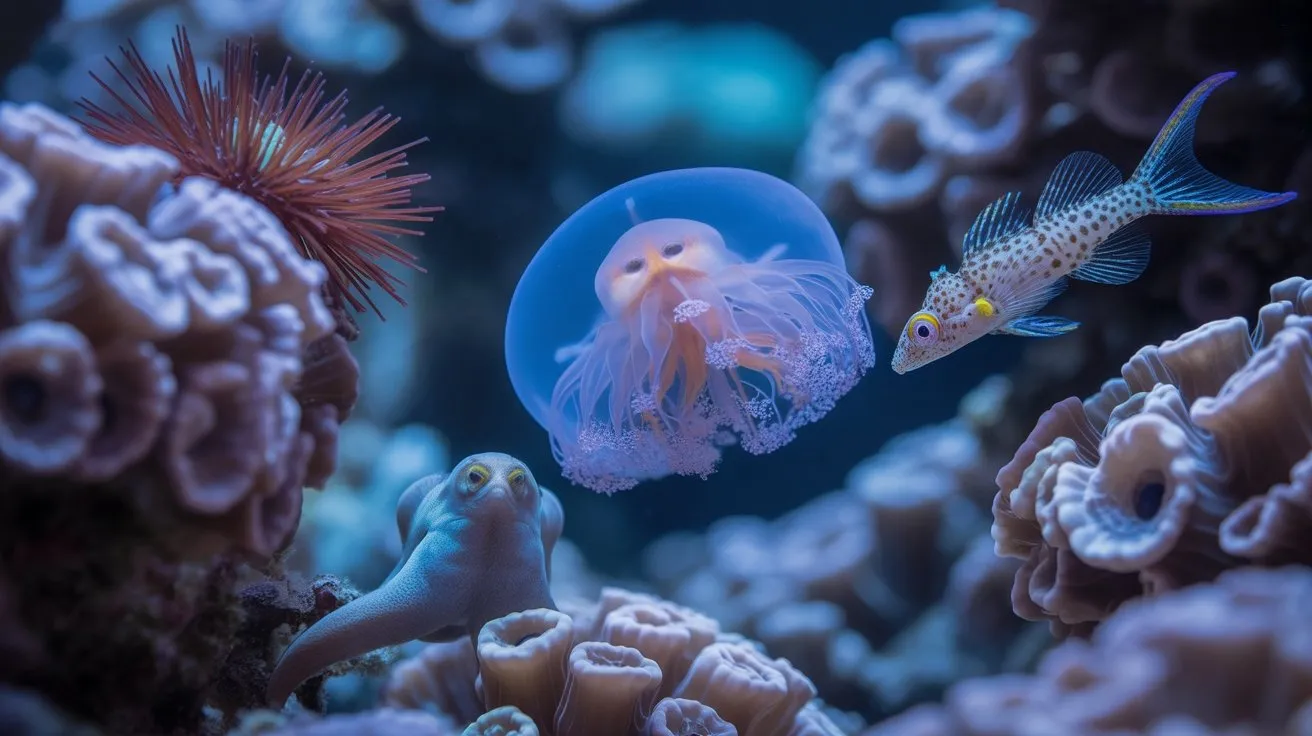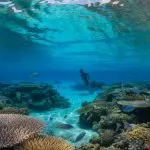You’ve likely never considered that mantis shrimp (Stomatopoda) possess sixteen types of photoreceptors compared to your three, enabling tetrachromatic vision that detects polarized light patterns invisible to most marine predators. These crustaceans execute strikes at 23 meters per second, generating cavitation bubbles that produce temperatures approaching those found on the sun’s surface. Yet they’re merely one example of the biomechanically extraordinary species that’ve evolved within scleractinian coral frameworks, each displaying adaptations that challenge conventional understanding of marine physiology.
Mantis Shrimp: The Ocean’s Most Powerful Predator
Stomatopods, commonly known as mantis shrimp, represent one of the most formidable predatory arthropods inhabiting coral reef ecosystems. You’ll encounter these raptorial crustaceans wielding specialized appendages capable of delivering strikes at 23 meters per second—equivalent to a bullet’s velocity.
Their compound eyes possess sixteen photoreceptor types, enabling tetrachromatic vision that surpasses human trichromatic capabilities. You’ll observe two distinct hunting strategies: “smashers” fracture molluscan shells and crustacean exoskeletons using calcified dactyls, while “spearers” impale soft-bodied prey with barbed raptorial claws.
These stomatopods inhabit burrows within coral substrates, maintaining territories they’ll defend aggressively. Their cavitation bubbles generate secondary shock waves during strikes, creating localized temperatures approaching solar surface conditions—making them remarkably efficient apex predators within reef food webs. Additionally, their role as keystone species highlights their importance in maintaining the balance of coral reef ecosystems.
Leafy Sea Dragon: Master of Underwater Camouflage
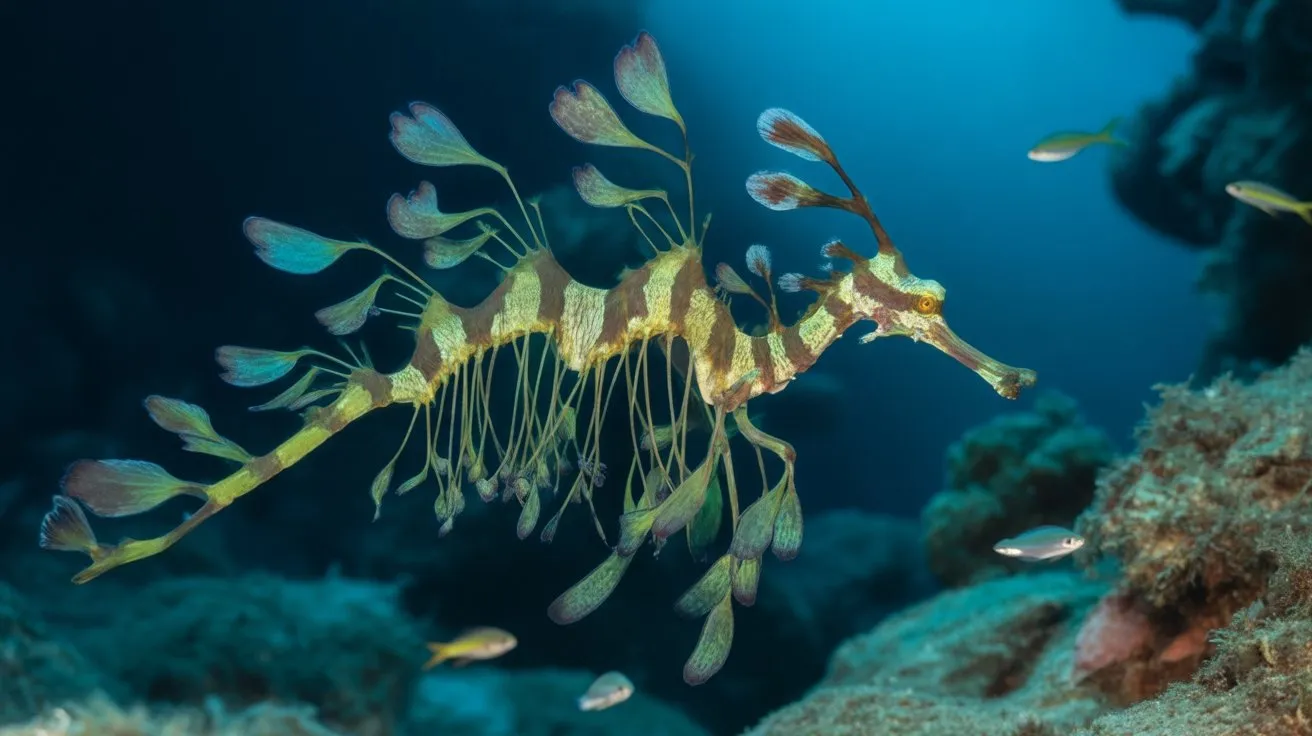
Phycodurus eques, commonly known as the leafy sea dragon, exhibits extraordinary morphological adaptations that render it virtually indistinguishable from floating marine vegetation.
You’ll observe this syngnathiform’s elaborate cutaneous appendages mimicking kelp fronds with remarkable fidelity. These dermal projections aren’t functional fins but specialized camouflage structures.
The species demonstrates:
- Cryptic coloration matching Sargassum and Macrocystis kelp species
- Elongated rostrum facilitating precise prey capture through suction feeding
- Absence of prehensile tail, distinguishing it from Hippocampus relatives
- Male brood pouch located beneath the tail for parental care
- Extremely limited locomotion capacity, rendering camouflage essential for survival
You’ll find P. eques exclusively in temperate Australian waters, where its morphological specializations enable effective predation on mysid shrimp while avoiding detection by larger predators through its exceptional phytomimetic adaptations. Additionally, its existence highlights the importance of biodiversity in coral reefs, as the leafy sea dragon is a unique example of how species have adapted to thrive in complex marine ecosystems.
Frogfish: Ambush Hunters With Lightning-Fast Reflexes
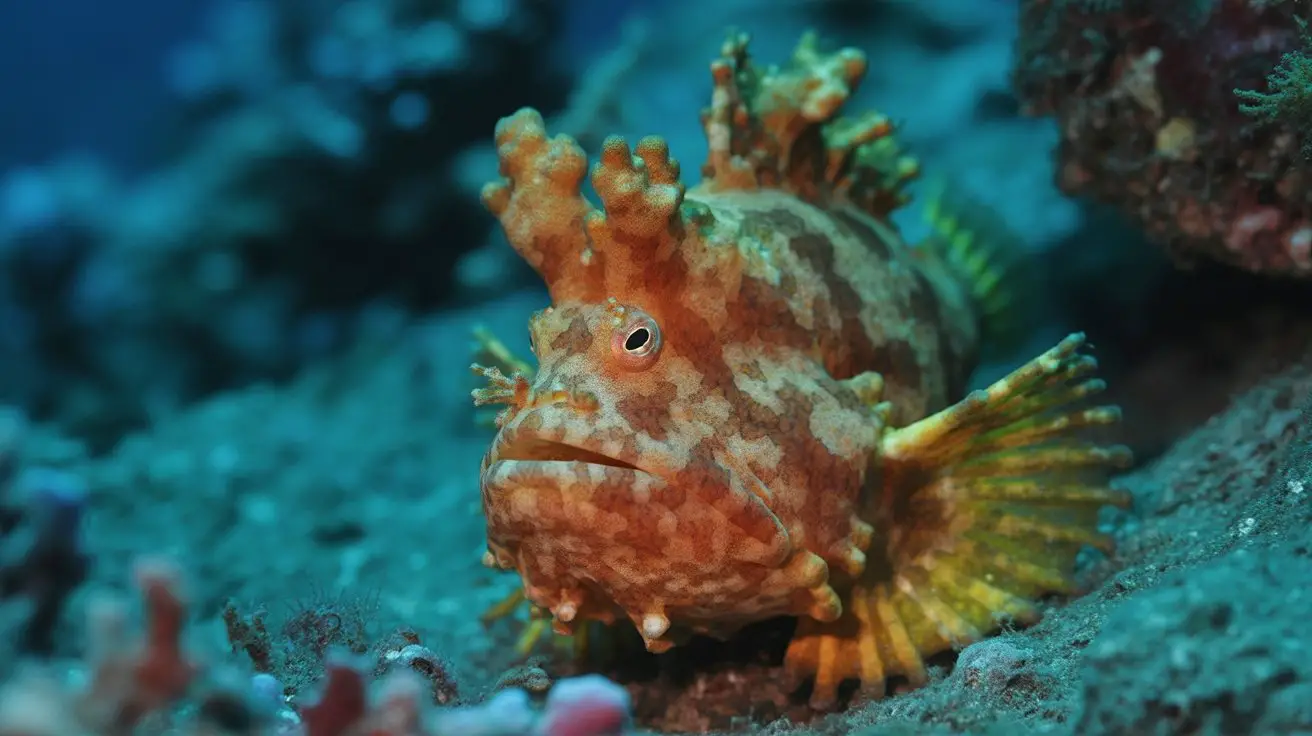
The Antennariidae family encompasses remarkable ambush predators that you’ll recognize by their globular bodies and extraordinary predatory mechanisms.
You’ll find these benthic specialists employing modified dorsal fins called illicium, which function as bioluminescent or chemically-enhanced lures. Their strike velocity reaches 6 milliseconds—faster than any vertebrate predator you’ve documented.
You’ll observe their prehensile pectoral fins gripping substrates while maintaining perfect camouflage through chromatophore manipulation. Their distensible stomachs accommodate prey exceeding their own body length.
When you examine their oral cavity expansion, you’ll witness suction forces generating negative pressure that’s virtually inescapable for target organisms.
Species like Antennarius maculatus demonstrate phenotypic plasticity, matching coral textures and reef formations.
You’ll notice their forward-facing eyes providing binocular vision for precise distance calculation during predatory strikes. These ambush hunters play a crucial role in regulating herbivore populations and maintaining the balance of coral reef ecosystems.
Cleaner Wrasse: The Reef’s Tiny Medical Professionals

Among coral reef ecosystems, Labroides dimidiatus represents one of nature’s most sophisticated mutualistic relationships, where you’ll observe these diminutive labrids functioning as specialized ectoparasite removers for hundreds of client species.
You’ll find these Indo-Pacific endemics establishing cleaning stations at specific reef locations, where they perform meticulous inspections of visiting fish. Their specialized dentition allows precise removal of copepods, isopods, and diseased tissue without damaging healthy scales.
- Territorial behavior: Males establish harems of 2-6 females within defined cleaning territories
- Client recognition: Distinguished between cooperative and non-cooperative clients through chemical cues
- Sequential hermaphroditism: Largest female transforms into male when dominant male disappears
- Feeding specialization: Consume 1,200+ parasites daily per individual
- Economic impact: Generate significant reef-wide health benefits through pathogen reduction. Additionally, their presence is crucial for maintaining healthy reef ecosystems, as they help control parasite populations that can otherwise harm fish health.
Mandarin Fish: Living Jewels of the Coral Garden

Synchiropus splendidus exhibits perhaps the most spectacular chromatic displays you’ll encounter within Indo-Pacific coral ecosystems, where these small callionymids navigate labyrinthine coral branches through intricate fin undulations.
You’ll observe their psychedelic patterns of electric blue, orange, and green creating complex geometric designs across their scaleless integument. These dragonets possess protrusible premaxillae for extracting copepods and amphipods from crevices.
You’ll notice their prominent pelvic fins function as stabilizers during benthic feeding behaviors. Sexual dimorphism manifests in males’ elongated dorsal fin extensions and larger opercular spines.
During crepuscular spawning events, you’ll witness synchronized ascensions where pairs release gametes into water columns above coral formations, completing reproductive cycles within reef microhabitats. Coral reefs provide essential habitats that support the diverse life cycles of these vibrant fish.
Octopus: Shape-Shifting Escape Artists
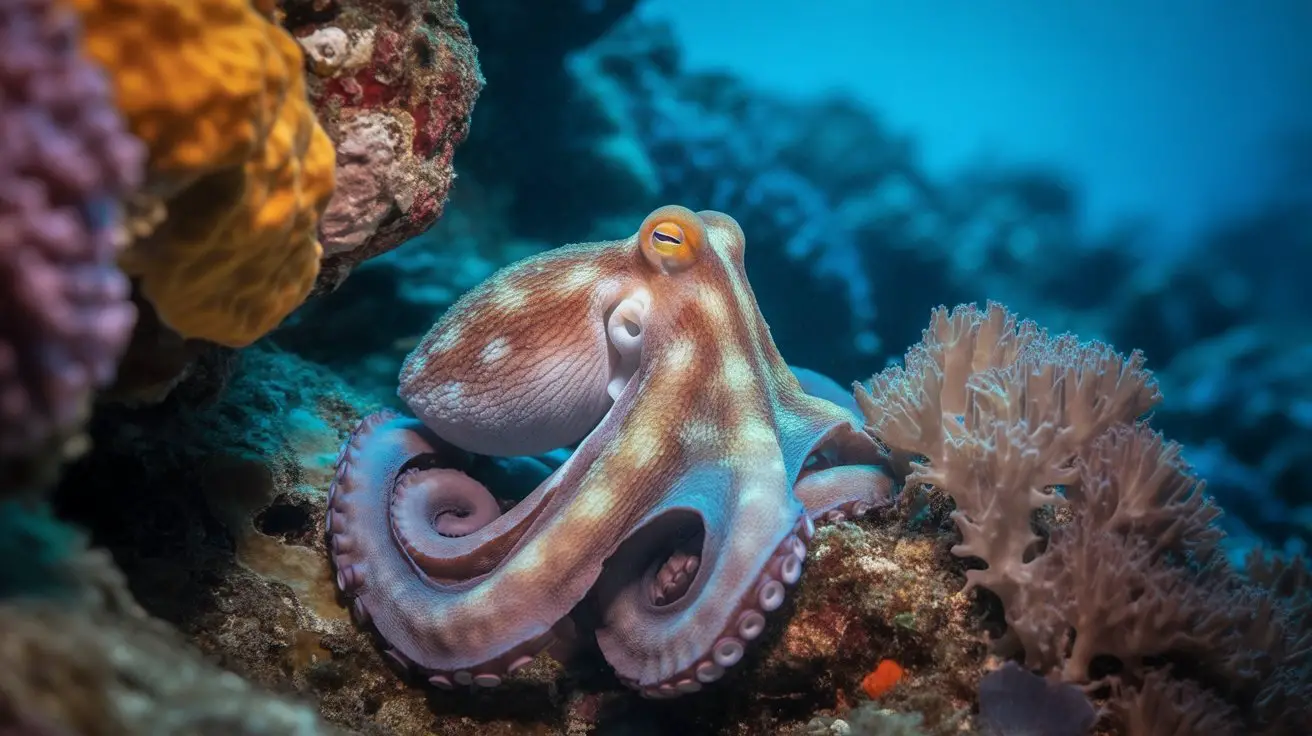
While mandarin fish captivate through chromatic brilliance, cephalopod mollusks demonstrate reef adaptability through morphological plasticity and neural sophistication.
You’ll observe octopuses (Order: Octopoda) executing remarkable camouflage through specialized chromatophores, iridophores, and papillae modifications. Their distributed nervous system enables rapid environmental assessment and substrate mimicry.
- Chromatophore arrays: Muscular sacs containing pigment granules contract milliseconds apart, producing instantaneous color changes
- Textural metamorphosis: Dermal papillae extend and retract, replicating coral surfaces, algae textures, and rocky substrates
- Behavioral thigmomorphism: Body molding against irregular surfaces through hydrostatic skeletal manipulation
- Neural decentralization: Two-thirds of neurons reside in arms, facilitating independent appendage coordination
- Bioluminescent mimicry: Some species replicate other organisms’ photophoric patterns for predator avoidance
In addition to these adaptations, octopuses play a crucial role in maintaining marine ecosystem balance by regulating prey populations and contributing to biodiversity.
You’re witnessing evolutionary masterpieces capable of near-instantaneous environmental integration through sophisticated neuromuscular coordination.
Nudibranch: Alien-Like Sea Slugs With Extraordinary Beauty

Beyond cephalopod camouflage mastery, gastropod mollusks showcase reef biodiversity through nudibranch specimens (Order: Nudibranchia) that’ll challenge your perception of marine invertebrate morphology.
You’ll observe shell-less gastropods displaying elaborate cerata—finger-like projections housing digestive diverticula and defensive cnidocytes sequestered from cnidarian prey. These aeolid nudibranchs concentrate nematocysts within cnidosacs, transforming stolen weaponry into personal defense mechanisms.
You’ll encounter dorid nudibranchs featuring retractable rhinophores—chemosensory tentacles detecting pheromones and food sources through lamellated surfaces. Their dorsal gills form branchial plumes encircling anal openings, creating distinctive rosette patterns.
Species like Chromodoris exhibit warning coloration through specialized chromatophores, advertising toxicity to potential predators.
You’ll witness extraordinary feeding specialization: Glaucus atlanticus targets siphonophores, while Elysia chlorotica practices kleptoplasty, sequestering functional chloroplasts for photosynthetic nutrition. This unique adaptation allows them to contribute to oxygen production within the coral reef ecosystem.
Their hermaphroditic reproduction involves elaborate courtship displays and simultaneous fertilization.
Conclusion
You’ve witnessed these extraordinary taxa functioning as living laboratories of evolutionary adaptation. Each species—from Odontodactylus scyllarus with its specialized raptorial appendages to Phycodurus eques demonstrating cryptic coloration—represents millions of years of selective pressure. Their specialized morphological features and behavioral adaptations create a complex foodweb matrix. These organisms serve as biodiversity’s insurance policy, maintaining ecosystem stability through intricate predator-prey relationships, mutualistic cleaning symbioses, and precise niche partitioning within the coral reef’s delicate ecological framework.
